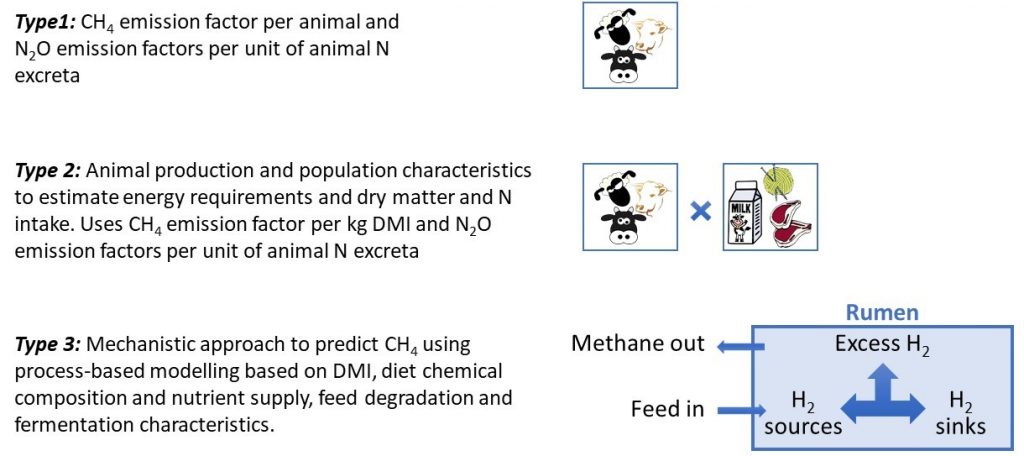Capturing dietary effects in on-farm greenhouse gas emissions models of ruminant systems
Summary
As part of CEDERS (Capturing Effects of Diet on Emissions from Ruminant Systems), a project funded through FACCE ERA-GAS, we investigated how well existing on-farm GHG accounting models for dairy cattle systems could capture the effect of dietary strategies for GHG abatement. In general, the better a model can simulate rumen function, the greater the opportunity to capture dietary mitigation strategies. All models can be refined to better capture dietary mitigation strategies, but the value of doing so should be a careful balance between gains in accuracy, the need for additional input and activity data, and the need for consistency with other approaches.
Background
Simulation models have an important role to play in estimating greenhouse gas (GHG) emissions from ruminant systems, and assessing the farm system impacts of potential GHG mitigation strategies such as animal feed choices and dietary management. We reviewed existing on-farm GHG accounting models for dairy cattle systems to explore their ability to capture the effect of dietary strategies in GHG abatement. The focus of the review was on methane (CH4) emissions from enteric and manure management sources and nitrous oxide (N2O) emissions from excreta and manure management sources.

Results
We identified three generic types of on-farm GHG models (Figure 1), based on the degree at which diet-related characteristics are captured: from ‘none’ (Type 1) to ‘some’ by combining key diet parameters with emission factors (EF) (Type 2) to ‘many’ by using process-based modelling (Type 3). Most of the models we reviewed have adopted a hybrid approach between Type 2 and Type 3 models. Type 2 models can use many key diet characteristics (e.g., dry matter intake DMI, organic matter digestibility OMD, and energy, protein and carbohydrate content) and then use a CH4 EF and a N2O EF to estimate GHG emissions. Some models only use different CH4 EF for different animal species while others further refine EFs for different diets or dietary ingredients. Empirical models based on commonly measured dietary inputs can predict CH4 and N2O emissions with reasonable accuracy. However, the impact of GHG mitigation strategies often needs to be assessed in a more integrated way, and Type 1 and Type 2 models frequently lack the biological foundation to do this. Only Type 3 models represent underlying mechanisms such as ruminal fermentation and total-tract digestive processes and excreta composition that can capture dietary effects on GHG emissions in a more biological and comprehensive way.
Figure 1: Overview of three generic approaches used by models to estimate on-farm greenhouse gas emissions from dairy systems.
Conclusions
In general, the better a model can simulate rumen function, the greater the opportunity to include diet characteristics in addition to common variables such as DMI and OMD, and thus the greater the opportunity to capture dietary mitigation strategies. However, capturing the effect of combinations of different feed additives and the potential interactions with diet composition will be an ongoing challenge. There are opportunities for all models to improve their ability to capture dietary mitigation strategies. The value of doing so, however, should be carefully balanced against gains in accuracy, the need for additional input and activity data, the variability encountered on-farm, and the need for consistency between different approaches used for different purposes (e.g. on-farm accounting vs. national inventory, vs. carbon footprinting).
Acknowledgements
This review was funded by: the New Zealand Government, in support of the objectives of the Livestock Research Group of the Global Research Alliance on Agricultural Greenhouse Gases (GRA; S7-SOW16-ERAGAS-CEDERS); the Ministry of Agriculture, Nature and Food Quality, The Netherlands (PPS project AF-EU-18010) and The Netherlands Organisation for Scientific Research (ALW.GAS.2); Ministry of Agriculture and Forestry, Finland; The Secretary of State for Environment, Food and Rural Affairs, UK; French National Research Agency, France; Federal Ministry of Food and Agriculture, Germany; TEAGASC and Department of Agriculture, Food and the Marine, Ireland; Innovation fund, Denmark; Research Council for Environment, Areal Industries and Community Development, Sweden.
Authors
Ronaldo Vibart, Cecile de Klein, Arjan Jonker, Tony van der Weerden, André Bannink, Ali R. Bayat, Les Crompton, Anais Durand, Maguy Eugène, Katja Klumpp, Björn Kuhla, Gary Lanigan Peter Lund, Mohammad Ramin, Francisco Salazar
